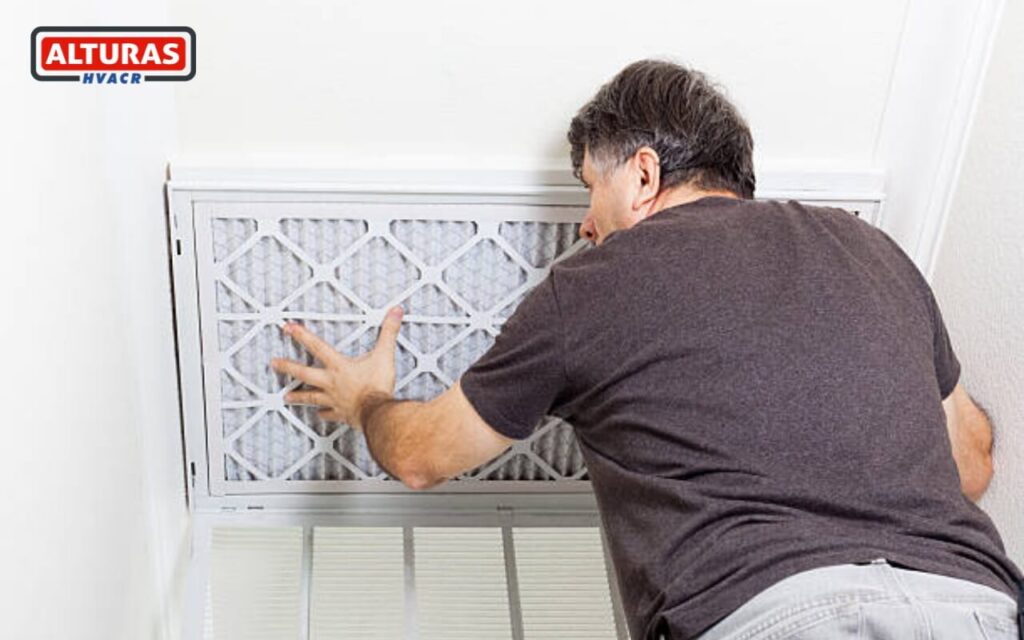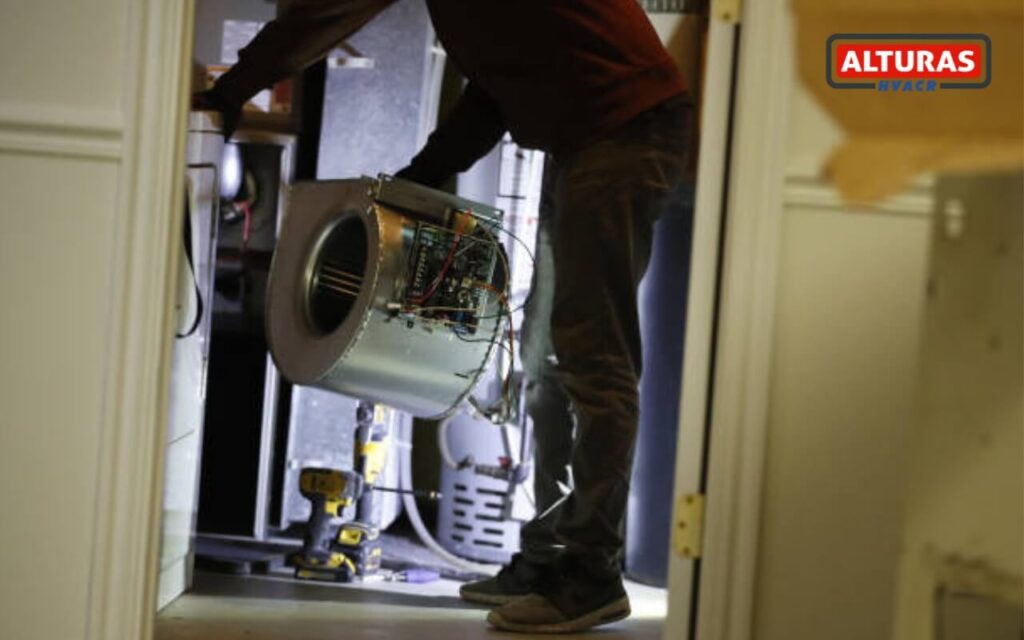To maintain your furnace and keep it functioning properly, we will always recommend annual servicing from a trained HVAC professional.
Your furnace must be cleaned at the start of each heating season, but ideally, mid-year would help in keeping your gas furnace in extreme conditions to prevent any future problems.
How to Clean a Furnace?
Well, cleaning a furnace is not complicated at all, it still offers a lot of benefits for the long-term health, efficiency, and reliability of your comfort system.
A lot of homeowners can take the first step by keeping the air filter cleaned or replaced per the manufacturer’s suggestions. Although some basic internal cleaning can be done by anybody and everybody. Appropriately maintaining the internal components of a furnace, such as a blower or flame sensor will demand a little more capability and the kind that can be offered by your local HVAC expert.
Importance of Furnace Cleaning and Maintenance
Understanding the importance of cleaning a furnace is very important because keeping your system’s inside surfaces free from any sort of dirt and debris can for sure help extend its performance. For instance, dirt buildup on the burners and heat exchangers can lessen the furnace’s ability to heat your home properly.
Along with it, a dirty blower can increase the furnace’s load and cause increased wear on a lot of its components. All these and many other issues can cause your furnace to work harder can reduce its expected lifetime.
If you are curious about the question, “What is the cost of furnace cleaning?” be sure to follow this blog till the end as it has everything explained.
Steps For DIY Furnace Maintenance

Below is the step-by-step guide on how you should clean your furnace by yourself
Shutting down the System
For DIY furnace maintenance, before performing anything, always make sure that you switch off the electrical power and the fuel supply. You can find the distinctive red power switchplate at the top of the cellar stairs or even near the burner itself, while the fuel shutoff valve would be near the oil tank or on the incoming gas pipe. You must see the location of both in case of a future leak or fire.
Cleaning the Combustion Chamber
Basically in the combustion chamber, different kinds of fuel mix with air and are burned generating heat as well as carbon soot, water vapor, carbon dioxide, and a lot worse. Usually, a buildup of this soot can cause the chamber walls to crumble. You can always scrape out all this built-up carbon with the help of a small wire brush. After that, you can remove loose material with an industrial shop vacuum, and you must also inspect the chamber for any sort of holes or corrosion before replacing the cover.
Inspecting the Flue Pipe
You must always check for any holes in the exhaust flue that can cause the leakage of carbon monoxide, especially where the pipe meets the furnace. All these small holes can be repaired with foil tape, but corroded flues must be changed on time. you must also adjust the flue pipe’s barometric damper, which moderates the chimney draw.
Replacing the Oil Filter
The furnace oil filter that is found in oil-powered systems only would help in preventing all those small impurities from clogging the oil-burner nozzle, which can also result in any sort of misfire that would shut down the entire system. You must first close the oil valve, then you may remove the old filter and replace it properly, setting aside the dirty filter to be disposed of according to local hazardous-waste regulations.
Changing the Air Filter
During the winter season, all that air that your family is breathing comes through this filter and you can not change it too often, but you should never let it go for more than a year. Changing these filters is very important, and this is something anyone can do easily.
At the same time, you must also check the blower belt’s wear and tension. (The blower, driven by an electric motor, moves heated air from the furnace through ductwork to room vents.) A loose belt can slow the blower, which would compromise its efficiency. If the belt deflects more than ¾ inch when pressed firmly, it can be adjusted by sliding the motor backwards slightly.
Adjusting the Burner and Testing Efficiency
You can also set up a combustion analyzer, which helps in calculating furnaces working just by measuring gasses in the exhaust flue. You must make sure that the burner’s air gates are adjusted for the proper ratio of fuel to air. You would want the fuel that you have spent money on brought to be burned before it goes up the chimney and gets wasted. You must also replace the oil nozzle, which atomizes the fuel just before it ignites, as well as you must check the flame color and shape at the igniter. For either oil or gas, this is a key sign for any stable and complete combustion. In a gas system, this is the time when the burner tubes should be vacuumed clean.
Cleaning Floor Vents
The fall is somehow a good time for any homeowner to remove floor registers and vacuum out the ducts, which can be the perfect magnets for dust, pet hair, small toys, and food scraps. All of this would reduce its efficiency, and it would force you to crank up the heat. You will also be able to breathe a little easier without any of this debris in the air.
How To Clean a Furnace Blower?
You must also know how to clean a furnace blower because it is not just important for the heating performance and working but it can also improve the overall performance of your central air conditioning system.
That is the reason that both of them use the same blower or air handler to circulate air into and out of the system. To perform this job properly, an HVAC professional might start by removing the blower assembly or “squirrel cage” to have better access for both inspecting and cleaning purposes
Keeping the blower assembly clean would always help in improving the airflow and motor efficiency and it will also reduce any risk for early motor failure. You must replace a blower so that you can save it from expensive repairs, so keeping it operating at its best would help save money in the long run. Also, by keeping the motor housing and blower motor cleaner and more dust-free, you must enjoy the improved indoor air quality with it.
How To Clean a Furnace Sensor?
Always remember that a furnace flame sensor is very important for the safe operation of your furnace. As it is located on the burner assembly, it may look like a metallic rod. These flame sensors detect the presence of a flame when the gas is turned on, and then shut down the system if no flame is detected.
A dirty flame sensor would also disrupt furnace operation, so it would be better to call an experienced HVAC technician who knows how to clean a furnace flame sensor as it can be a boost for safe and reliable operation.
To clean its sensors, your local HVAC professional will turn off the furnace and remove the sensor from the burner assembly. Because the sensor is exposed to flame regularly, it is prone to gritty build-up on its surface which will need to be lightly sanded and wiped off. In case performance does not improve after its cleaning, there are chances that your sensor may need to be replaced.
How to Clean a Furnace Coil?

Well the question of how to clean furnace coils, actually refers to how to clean your evaporator coil. This evaporator coil is attached to your furnace cabinet, and it is a crucial component for your central air conditioner or your heat pump. You must keep it clean so that it can help maintain cooling or heating performance and energy efficiency properly.
To clean the coil, your HVAC service technician will typically turn off the system and remove the access panel from the coil cabinet. All these techniques may differ, but some technicians will apply a “rinse less” coil cleaner spray and follow up with a soft, gentle brush to remove difficult-to-remove debris.
Contact a Professional
As we have told you the basics of furnace cleaning are very simple, but getting the job done right would help in improving the life span and overall performance of your heating and cooling system. That is the reason we always recommend that you contact any certified HVAC expert to get an estimate for your home. Your HVAC expert can also evaluate your system’s performance, make needed repairs, and make recommendations for improved performance.
How to clean your Gas Furnace FAQ’S
What is the cost of furnace cleaning?
Average Furnace Repair Cost
On average, a property owner usually spends $289 on any sort of furnace repair. Most of these homeowners spend between $131 and $458. In case you have an electric furnace, you must expect to pay around $300. The cost of gas furnace repair can usually range from $375 to $1,200 as they are a little bit more complicated.
Oil Furnace Repair Cost
Oil furnace repair can cost you anywhere between $300 and $1,200 and it usually depends on the issue it has. Usually, the oil furnaces function in the same way as their gas counterparts and often run into the same problems as a gas furnace.
Electric Furnace Repair Cost
You must expect to spend around $300 on repairs. Also, a new electric element can cost you an extra $50-$200. You will also have to pay around $100-$300 for labor.
How Often Should Furnace Be Cleaned?
Usually, we recommend that you must schedule furnace maintenance after every 1-2 years preferably once a year, and duct cleaning at intervals of 3 to 5 years for a proper-running system and excellent indoor air quality.
But also that is the minimum. You also need to handle these important repairs more often. In case you own an older furnace, have a large family or some pet dander in your home, suffer from breathing problems or notice any signs your furnace is not performing up to the mark you will have to do the repairs more often.
How to clean a furnace burner?
To clean a furnace burner, turn off the power, remove the burner assembly, vacuum away debris, wipe surfaces with a damp cloth, and inspect for any damage or corrosion. Reassemble carefully.
How to clean a furnace ignitor?
To clean a furnace ignitor, turn off power, disconnect the ignitor, gently brush off debris with a soft brush, and wipe with a dry cloth. Avoid using water. Reconnect securely before restarting.
How to clean a furnace filter?
To clean a furnace filter, turn off the system, remove the filter, vacuum or rinse with water (if reusable), let it dry completely, and reinstall. Replace disposable filters as recommended by the manufacturer.
How to clean a furnace heat exchanger?
Cleaning a furnace heat exchanger requires professional expertise. Hire a licensed technician to inspect, clean, and address any issues. Regular maintenance ensures efficient heat transfer and safe operation.
How to clean a furnace humidifier?
To clean a furnace humidifier, turn off power, disconnect water supply, remove and clean the water panel or filter, scrub the reservoir, and disinfect components using a vinegar solution. Reassemble and restart.

